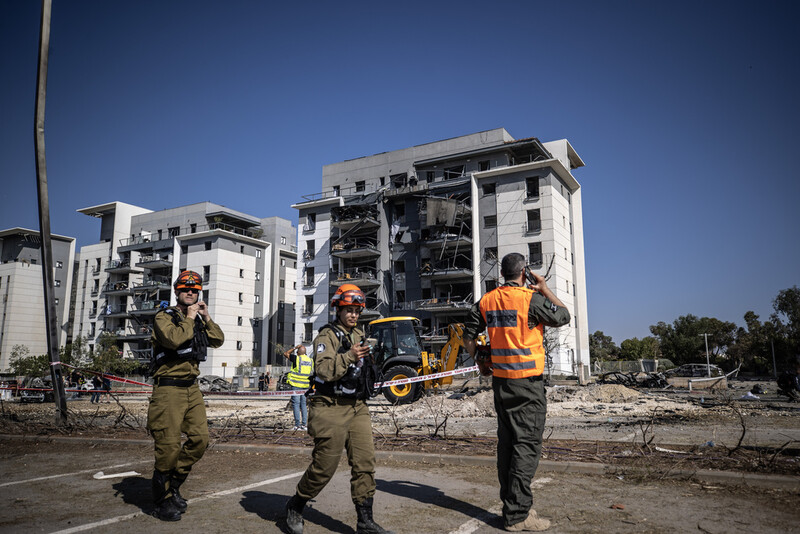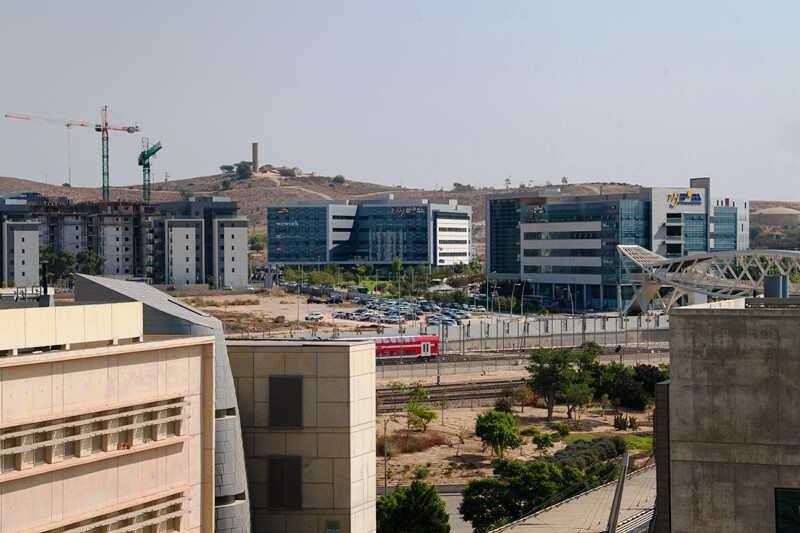The Electronic Intifada Podcast 20 June 2025

Israeli police officers and bomb disposal experts at the impact site after a missile launched from Iran struck an Israeli cyberwarfare complex in Beersheba, southern Israel, 20 June 2025.
Anadolu ImagesAn Iranian ballistic missile strike devastated a key Israeli military cyberwarfare base in Beersheba, in the southern Negev region, early Friday morning.
But you wouldn’t know it from Israeli media, which remains under strict military censorship.
That was followed by heavy Iranian strikes in several cities Friday afternoon.
These strikes are the latest response from Iran to the full-scale war of aggression that Israel launched against the country on 13 June.
The Electronic Intifada’s Jon Elmer takes a look at the effect of Iranian missiles in a special video report published hours before Friday’s strike on the cyberwarfare base.
You can watch his report in this video or listen to it in the Soundcloud player at the bottom of the page.
Israel’s attack on Iran “all roots back to the failure” of its war on Gaza, Elmer says. “Israel’s intention for the war on Gaza is that it would last a couple of months and they would roll over the resistance and take control in Gaza.”That, however, has not happened. Instead, Israel is perpetrating genocide and running amok all over the region, trying to redraw its borders.
Elmer provides context and analysis for the more than 400 Iranian ballistic missile strikes since Israel started the war one week ago.
“The Iranian military got its footing quite impressively quickly,” after Israel’s surprise attack which killed several top military commanders, Elmer said. Iran was “able to strike back within hours against Tel Aviv and Haifa as well as military bases.”
Iran produces its own indigenous missiles at a rate likely to outpace the ability of the US and Israel to manufacture interceptors to try to shoot them down, according to Elmer. That suggests “a war of attrition could favor Iran in this battle.”
Censorship attempts to conceal real target
Elmer recorded the special report before Friday morning’s Iranian strike on the Israeli cyberwarfare base in Beersheba, which this article examines in detail.
On Thursday, an Iranian strike damaged the nearby Soroka Medical Center, which Israel claimed was deliberately targeted at the civilian and military hospital. However, Iran asserted that its real target was the nearby cyberwarfare base that was directly hit on Friday.
Friday morning’s strike “caused extensive damage in the area,” Haaretz reported, citing the mayor of Beersheba.
The Israeli newspaper characterized the target area only as “several apartment buildings.”
Similarly, The Times of Israel described the missile strike as “lightly wounding seven people and causing substantial damage to homes.”
“There’s major damage,” the mayor said, according to that publication.
The US network ABC, among others, also described the damaged site in Beer Sheba as merely a “residential building.”
Israel unable to defend military asset
Crucially, the Israeli army acknowledged that it failed to shoot down the missile, claiming that its interception system suffered a “malfunction.”
This is more than usually significant, because what Iran targeted was not just an ordinary residential area, but a major Israeli military base – the so-called IDF ICT campus, part of the Gav Yam high-tech park – along with housing for thousands of Israeli military and security personnel.

A photo published by Ben-Gurion University in 2018 shows the Israeli military’s Gav Yam cyberwarfare campus in Beersheba under construction. A clear resemblance can be seen to buildings damaged in an Iranian missile strike on 20 June 2025. (Ben-Gurion University)
Photos and videos taken after the attack show fire raging near the offices of Microsoft, the US software giant, which is deeply involved in Israeli military projects and is complicit in Israel’s genocide in Gaza, according to current and former employees.
CNN also reported fire was raging near the Microsoft offices in a “technology park” in Beersheba following the attack.
Other images identify the area of the attack to be the Gav Yam technology park – as indicated by the sign in Hebrew on one of the damaged buildings.The “apartment buildings” seen in photos and videos of the aftermath of the Iranian attack clearly resemble housing associated with the military-led project, published in 2018.
Military-led colonial settlement
The Gav Yam park is a major Israeli military project to create a high-technology campus and home for its cyberwarfare units, alongside private firms with which the military works.
Along with Microsoft, Gav Yam’s tenants include such US and European tech giants as Amazon, IBM, Apple, Motorola and Philips, as well as Israeli weapons firms including Rafael and Elbit Systems.
The Israeli defense ministry and prime minister’s office are also Gav Yam tenants.
A public-private partnership, the Gav Yam park is part of a drive to establish a stronger Israeli Jewish hold in the Naqab, or Negev, region, displacing or outnumbering the indigenous Palestinian Bedouin population.
The Gav Yam company is a private sector developer that has provided financing for the project from its early phases.
But the whole project “is being led by the Southern Transitional Authority at the Ministry of Defense, the ICT and Defense Division at the Defense Intelligence Agency and the IDF Planning Division,” the Israeli military explained in 2021.
“Our best men are the first to lead the realization of the vision – IDF soldiers and commanders are the ones leading the national move to develop the Negev,” General Aviv Kochavi, then Israel’s army chief, boasted.
Known as Kiryat HaTikshuv in Hebrew, the base includes housing for “12,000 soldiers and security officers,” according to TNM, the civil engineering firm hired by the Israeli defense ministry to manage the project.
Incorporating the Israeli military’s “IDF C4I technological base,” the campus was designed to be “integrated into the technological ecosystem in the Beersheba metropolitan area, alongside government ministries, the municipality, the university and the local industry.”
C4I stands for “command, control, communications, computers and intelligence.”
Academic complicity
The academic institution involved in the project is the Ben-Gurion University of the Negev (BGU), which in 2022 celebrated the arrival of the Israeli military’s “cyber defense unit” to the new technology park.
“Soldiers will have close relations with BGU researchers, leading to joint projects and a fertile exchange of ideas,” The Times of Israel reported in 2018, as construction was still underway.In 2022, the Israeli army inaugurated its “school for computing professions of the IDF” located “in the heart of the high-tech park,” according to the publication Israel Defense.
“About 1,000 trainees, commanders and officers will serve in this innovative base,” Israel Defense reported.
The Gav Yam cyberwarfare campus is a prime example of Israel basing explicitly military facilities among civilians – effectively using them as human shields.
Every aspect of the area attacked by Iran reflects Israel’s militaristic and settler-colonial nature, including the two construction firms contracted to build the campus: Shikun & Binui and Africa Israel.
Both have long been the target of international divestment campaigns because of the major role they play in building illegal Israeli settlements in the occupied West Bank.
New strikes
Iran launched new strikes on Israel Friday afternoon, triggering sirens across Israel.
From Amman, this writer observed about five or six missiles heading towards the Tel Aviv area and at least another three heading in the general direction of Haifa.
Early reports and videos indicated that at least one impact was near Haifa’s so-called Sail Tower, a skyscraper housing Israeli government offices.
Jon Elmer’s special report was produced by Tamara Nassar.




Comments
This is just brilliant, Ali.
Permalink Samina Ali replied on
This is just brilliant, Ali. The identification of the buildings is phenomenal research work. Thank you!
On another note, someone needs to deconstruct the false news and bias of Al Jazeera in reporting on this war. Any takers?
S.
Add new comment